What to Expect During Pelvic Health Physical Therapy
If you’ve been referred to pelvic health physical therapy—or you’re considering it—you may be wondering what the experience will actually be like. Knowing what to expect can ease anxiety and help you feel more confident taking this step for your health.

A Whole-Person Approach
A pelvic health physical therapist (pelvic health PT) has specialized training in pelvic floor muscle dysfunction and its impact on your daily life. Your pelvic health PT will perform a thorough evaluation in a private setting during your first visit to understand your symptoms and how it is interfering with your activities..You’ll be asked questions about your eating, drinking, and bathroom habits. Whether you’re seeking help for bladder or bowel issues, pelvic pain, postpartum recovery, or sexual health concerns, treatment is tailored to your unique needs.
During your initial evaluation, your pelvic health PT will begin with a thorough discussion of your symptoms, lifestyle, and health history. They may ask about:
-
Bladder and bowel habits
-
Pain symptoms and triggers
-
Pregnancy or birth history
-
Surgeries or injuries
-
Physical activities, hobbies, and/or daily routines
A physical assessment is performed and often includes an external assessment looking at posture, breathing, core strength, lower extremity strength, flexibility, range of motion, and movement patterns. With your consent, it may also include an optional external and/or internal pelvic floor muscle exam to check for muscle strength, coordination, trigger points, tender spots, or tension. Although a detailed assessment of your pelvic floor is helpful, it is not necessary if you do not feel comfortable with this type of assessment..
Biofeedback may also be used during the initial visit if determined necessary by your physical therapist. Biofeedback is a technique using surface or internal electrodes that detect muscle activity and help your physical therapist teach you to contract or relax your pelvic floor muscles. Pelvic floor muscle activity is displayed on a screen, which allows you to see or hear how well you are using your muscles, so you can better understand proper muscle function. Biofeedback may also be used to monitor your progress over time. Some physical therapists utilize lumbopelvic ultrasound to visualize the pelvic floor muscles to help you improve strength, relaxation, or coordination.
Treatment Options
Your physical therapist will discuss a treatment plan with you that will include the frequency and duration of your therapy sessions and planned interventions.
Based on your assessment, your physical therapist will develop a plan that may include:
-
Education – learning about pelvic anatomy, bladder/bowel habits, dietary/fluid modifications, stress management techniques, and/or lifestyle strategies
-
Exercises – gentle strengthening or relaxation exercises for the pelvic floor, hips, back, abdominal,s and core
-
Manual therapy – hands-on techniques to release tight muscles or improve mobility
-
Biofeedback or other tools – technology to help you see and control your muscle activity
-
Home program – personalized strategies to practice between visits
Your Role in Recovery
Progress comes from teamwork. You’ll be encouraged to actively participate in your care, practice your home program, and share feedback with your pelvic health physical therapist along the way. Many people notice improvements within a few weeks, though the timeline depends on your condition and goals.
A Safe and Supportive Space
Above all, pelvic health physical therapy is meant to be a safe, respectful, and empowering experience. You are in control of your treatment decisions, and your physical therapist is there to guide you with compassion and expertise. Most patients who attend pelvic health physical therapy report high satisfaction with their experience and would recommend it to their friends and family.
Helpful Resources
-
Find a PT or PTA Specializing in Pelvic Health - PT Locator is a directory that helps patients find a licensed Physical Therapist / Physiotherapist (PT) or Physical Therapist Assistant (PTA) who specializes in pelvic and abdominal health physical therapy in their area. Whether you're recovering from an injury, managing a chronic condition, working toward strengthening your pelvic floor, or seeking specialized care, PT Locator connects you with trained clinicians dedicated to your well-being. Learn more about the benefits of pelvic and abdominal health physical therapy.
-
Questions to Ask Your Physical Therapist - Choosing to participate in physical therapy, or specialized (pelvic, obstetric, lymphedema) physical therapy, can seem like a daunting experience. Discussing personal and sensitive topics such as pelvic pain, along with bladder, bowel, and/or sexual concerns, can be difficult. Check out our list of questions we recommend asking your pelvic health physical therapist at your first appointment.
-
About the Academy of Pelvic Health Physical Therapy - The Academy of Pelvic Health Physical Therapy, a component of the American Physical Therapy Association (APTA), is dedicated to advancing the field of pelvic and abdominal health through education, research, clinical practice, and advocacy. The Academy equips physical therapists, physical therapist assistants, and students with specialized knowledge and skills to improve patient outcomes, expand awareness of pelvic health, and foster an inclusive community of professionals worldwide.


